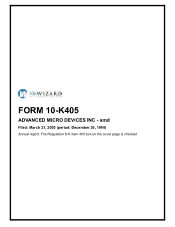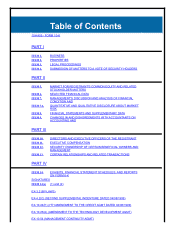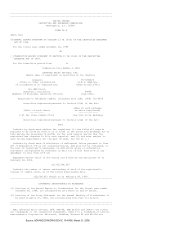AMD 1999 Annual Report Download - page 9
Download and view the complete annual report
Please find page 9 of the 1999 AMD annual report below. You can navigate through the pages in the report by either clicking on the pages listed below, or by using the keyword search tool below to find specific information within the annual report.Product Groups
In 1999, we participated in all three technology areas within the digital IC
market--microprocessors, memory circuits and logic circuits--through our
product groups--Computation Products Group (CPG), Memory Group, Communications
Group and our programmable logic subsidiary, Vantis Corporation. On June 15,
1999, we sold Vantis to Lattice Semiconductor Corporation.
Computation Products Group
CPG products ($1.7 billion, or 58 percent, of our 1999 net sales) include
microprocessors and core logic products, with the majority of CPG's net sales
being derived from Microsoft Windows compatible microprocessors, which are
used primarily in PCs.
In 1999, our most significant microprocessor product was the AMD-K6-2(R)
processor with 3DNow!(TM) technology, a sixth-generation microprocessor
product and a member of the K86(TM) microprocessor family. The K86
microprocessors are based on superscalar RISC architecture and are designed to
be compatible with operating system software such as Windows NT(R), Windows 98
and their predecessor operating systems, Linux, Netware and UNIX. The AMD-K6
microprocessor was designed to be competitive in performance to Intel's sixth-
generation microprocessor, the Pentium(R) II, which was designed by Intel
specifically for desktop PCs.
We commenced initial shipments of AMD Athlon(TM) microprocessors in June
1999 and began volume shipments in the second half of 1999. The AMD Athlon
processor is an x86-compatible, seventh-generation design featuring:
. a superpipelined, nine-issue superscalar microarchitecture optimized for
high clock frequency;
. a fully pipelined, superscalar floating point unit;
. high-performance backside L2 cache interface;
. enhanced 3DNow!(TM) technology with 24 additional instructions designed
to improve integer math calculations, data movements for Internet
streaming, and digital signal processor (DSP) communications; and
. a system bus which is a 200 MHz system interface based on the Alpha(TM)
EV6 bus protocol with support for scalable multiprocessing.
Sales of AMD Athlon processors are highly dependent in 2000 upon the
successful design, manufacture and delivery of processor modules by
subcontractors. Overall CPG sales growth in 2000 is dependent upon a
successful production ramp to .18 micron process technology and copper
interconnect technology, availability of chipsets and motherboards from third
party suppliers and expanding market acceptance of AMD Athlon microprocessors.
Our microprocessor products have in the past significantly impacted, and
will continue in 2000 to significantly impact, our overall revenues, profit
margins and operating results. We plan to continue to make significant capital
expenditures to support our microprocessor products both in the near and long
term. Our ability to increase microprocessor product revenues, and benefit
fully from the substantial financial investments and commitments that we have
made and continue to make related to microprocessors, depends upon the success
of AMD Athlon, AMD-K6 and future generations of K86 microprocessors. The
microprocessor market is characterized by short product life cycles and
migration to ever higher performance microprocessors. To compete successfully
against Intel in this market, we must transition to new process technologies
at a faster pace than before and offer higher performance microprocessors in
significantly greater volumes.
Intel has dominated the market for microprocessors used in PCs for many
years. Because of its dominant market position, Intel has historically set and
controlled x86 microprocessor standards and, thus, dictated the type of
product the market requires of Intel's competitors. In addition, Intel may
vary prices on its microprocessors and other products at will and thereby
affect the margins and profitability of its competitors due to its financial
5
Source: ADVANCED MICRO DEVIC, 10-K405, March 21, 2000






















